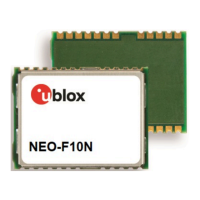NEO-F10N-Integration manual
• V_BCKP supply is optional. If present, the hardware backup mode is supported. This mode
maintains the RTC time and GNSS orbit data in the battery-backed RAM memory if the main
supply is switched off.
If there is no backup supply, time aiding with the UBX-MGA-INI-TIME_UTC message (optionally
with a timing signal at the EXTINT pin) and the GNSS orbit data from the AssistNow services or
stored on the host controller can be used to reduce the TTFF.
• For an absolute minimum design, all the PIOs (RESET_N, EXTINT, TIMEPULSE, LNA_EN, and
SAFEBOOT_N) can be left open.
Figure 14: Typical design
B.2 Active antenna design
Here are some key features for a NEO-F10N design with an active antenna:
• Designs using active antennas must not exceed 25 dB gain. For antenna gain above 25 dB, the
internal LNA mode can be changed to low-gain or bypass mode.
• The active antenna can be supplied either with the VCC_RF output from NEO-F10N as shown in
Figure 16 or from an external supply as shown in Figure 15. In both figures the supply is controlled
by the LNA_EN signal. The LNA_EN signal combined with the dual MOSFET switches on/off the
antenna power supply when VCC supply is removed or during software standby mode, saving the
antenna power consumption during the off periods.
• Designs using the VCC_RF output to supply the GNSS antenna require a current limiter circuitry
in case of short circuit on the antenna side. Figure 16 shows the required components. The R17
resistor value defines the maximum current in case of antenna short circuit.
UBXDOC-963802114-12193 - R02
Appendix Page 37 of 42
C1-Public

